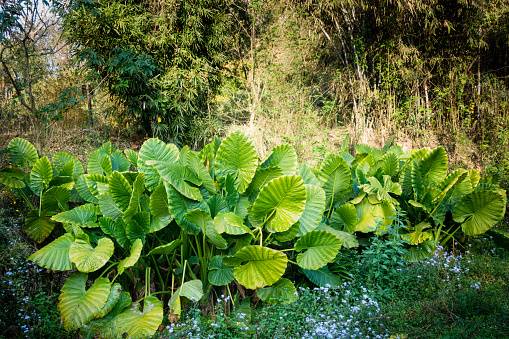How to Grow & Care for Alocasia Macrorrhiza ‘Giant Taro’ (2024)
Hey folks! Do you want to grow one of the best flowering plants in your garden? If yes, then you are here at the right place. Alocasia macrorrhiza is one of the best plants that increase the appearance of your garden with its large elephant ears-shaped leaves. It even serves as a source of starch. This plant is available in all parts of the country.
Alocasia macrorrhiza is the easiest plant to grow at home and even easier with the help of this guide. So, don’t rush and scroll down to know about how to grow and care for Alocasia macrorrhizos ‘Giant Taro’.
| Quick information | |
| Other Names | Giant Elephant Ears, Biga, Upright elephant ears etc |
| Type of plant | Rhizomatous tropical perennial |
| Soil used | Well-drained soil, loamy and slightly acidic soil |
| Water requirements | Only when the top layer is dry |
| Blooming period | Giant Elephant Ears, Biga, Upright elephant ears, etc |
| Color of flower | Produces greenish-yellow colored flowers |
| Native area | South East Asia and also Australia |
How to grow Alocasia macrorrhiza ‘Giant Taro’?
As I told you earlier, it is easy to grow Alocasia macrorrhiza in your home garden. It will develop large green-colored leaves. You will be happy to know that it is one of the food crops to be used in cuisine in Europe and even Asia. So, without wasting time, let’s move further to know the process of growing Alocasia macrorrhiza:

Via seeds:
Step 1- First, you have to buy seeds from the market which gives you a reasonable price.
Step 2- Choose a well-drained container and peat moss potting mix to it.
Step 3- Then by digging a hole in it, sowing the seeds in it.
Step 4- Do not plant the seeds too deep as it can harm the growth of the plant.
Step 5- You have to be patient in this process as this may take more time in comparison with the propagation process.
Step 6- When you will observe sprouts, then you can replant them in another pot in its permanent space.
Hint: Even it can take some more months for the seeds to become mature and attain a good height with big leaves.
| Benefits of growing Alocasia macrorrhiza |
| It helps in improving the heart health of an individual. |
| It helps in curing vitamin deficiencies. |
| It has ingredients that help in curing insomnia. |
| Facing any skin-related issues? It can help you out. |
How to Care for Alocasia Macrorrhiza ‘Giant Taro’?
Growing any plant is easy as you just have you follow the steps but also you have to care for your plant just like Alocasia macrorrhiza. So, follow the below guide to know how to care for Alocasia Macrorrhiza ‘Giant Taro’:
Sunlight requirements
- Alocasia macrorrhiza tends to grow in bright and indirect sunlight.
- You can provide them with morning sunlight as it is the best sunlight for growth.
- Also, feed them with some shade if possible so that the plant grows evenly.
- Full sunlight for about 2 hours every day for these plants is good.
Water requirements

- Being a water-loving plant, it can bear standing water for some time but not soggy.
- Water the plants when the top layer of the soil is dry.
- Make sure you are not overwatering your plant as it can cause yellow-colored leaves.
- Watering them one to two times a week would be great.
Soil requirements
- Making use of peat moss, perlite, and potting mix would be good for these plants.
- the pH level of the soil for these plants should be between 5.7 to 6.3.
- It will grow in well-drained soil with any mix.
- Soil needs to be less acidic.
Fertilizer requirements
- It is one of the heavy feeder plants, so it needs to be fertilized daily.
- Make sure you are not over-fertilizing the plant as it can cause root rot in the plant.
- You can make use of liquid-diluted fertilizer for houseplants.
- Also, add slow-release fertilizer to enhance the growth of the plant.
Temperature and humidity
- As they can thrive in warm conditions, the ideal temperature for these plants would be between 55 degrees to 85 degrees.
- If you have placed it outside, then when the temperature slows down, keep the plant inside.
- It is one of the humid-loving plants, so 50-60% of humidity would be suitable for them.
- Mist the leaves a few times in a week to set their temperature and avoid inconvenience.
Pruning requirements
- Just like every plant it also needs to be pruned so that it grows new leaves.
- For controlling its size, you have to prune off its leaves.
- Damaged leaves need to be cut off as soon as possible as they can harm the whole plant.
- Make sure to use clean and sterilized scissors for pruning.
Some of the problems with Alocasia macrorrhiza
Being a great plant, it is easy to grow but also it needs to be maintained properly to avoid any attack of pests, diseases, etc. Let’s have a look at the common problems of the Alocasia macrorrhiza:

Pests
One of the issues with the Alocasia macrorrhiza is pest infestation. Aphids, bugs, and mites tend to attack the plant to suck its fluid and satisfy its hunger.
So, all you have to do is to clean the leaves with the help of alcohol dipped cotton ball.
Else, you can even make use of neem oil so that the pests go away from the plant.
Falling off leaves
Another issue is the falling off leaves of giant taro. The main reason behind the falling off leaves is the supply of more sunlight to the plants which puts stress on the leaves of the plant and they droop.
So, it is suggested to prune off the dead or yellow-colored leaves.
Root rot
Last, but not least, it is another problem faced by Alocasia macrorrhiza. It is a fungal infection that will spread to the soil and can be spread all over the plant.
So, you have to catch it as early as you can so that you can prevent your plant from spoiling. Remove all the infected leaves from the plant.
Wrapping up the context
In this guide, you come to know about the Grow & Care for Alocasia Macrorrhiza ‘Giant Taro’. If you want to grow the best tropical plant, then this is one for you. Even I grew this in my home garden and I am satisfied with the results. So, I recommend you grow this in your home garden to add more to your collection. For any queries, just scroll down the guide, and you will for sure come to know about it.
Thanks for reading! Happy gardening!


